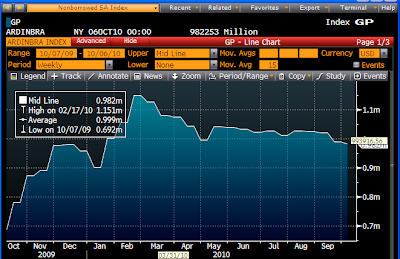Thursday, October 7, 2010
We don't need QE2
Top chart: Adjusted bank reserves. Bottom chart: M2
The investing world has worked itself into a frenzy of anticipation over the arrival of a second wave of Quantitative Easing from the Fed, which is supposedly going to be announced at the FOMC meeting in early November. The idea behind QE2, as it's called, is that the economy needs to be force-fed more money in order to pump up growth; $1 trillion of added reserves in late 2008 didn't help much, so we need a lot more.
This idea deserves to be buried alongside the corpse of Keynesian economics. Government spending can't boost growth because government spends money very inefficiently (especially when the spending program is designed by Pelosi, Reid & Co., and consists mainly of transfer payments and payoffs to unions). Government spending also needs to be paid for, and the funds that are borrowed to finance the spending represent funds that are removed from the pool of capital available to finance private sector initiatives. Similarly, quantitative easing can't boost growth for the simple reason that growth only comes from initiatives that boost productivity and/or increase the total number of people working. Printing money ultimately results only in higher prices, not a bigger economy.
The only justification for quantitative easing is as an offset to a dramatic increase in money demand. That was indeed the case in late 2008. The financial crisis shocked people all over the world into suddenly wanting to hold more money, and the dollar was the favored recipient of that new-found attraction for money. The Fed needed to supply a lot of extra money to the system, otherwise we would have likely fallen into a serious deflation.
But since the economy is now largely out of the woods and money demand is slowly declining, more quantitative easing is not only unnecessary but also potentially dangerous. The gold market is telling us that investors all over the world are growing increasingly concerned that central banks are making serious inflationary errors; gold is up because their demand for money has been seriously undermined. More of the same could accelerate the process of declining money demand, and that would be like adding fuel to the inflationary fires that have already been kindled.
Putting aside the theoretical arguments, let's look at the two charts above. What they are telling us is that the Fed's provision of reserves to the banking system has been declining since the end of February, while the amount of money sloshing around the economy (M2) has been increasing. Bank reserves have fallen by $170 billion, while M2 has increased by $270 billion. M2 is currently increasing at an annualized rate of over 6%. The increase in M2 has absorbed some of the excess reserves in the system, and the Fed's balance sheet has shrunk a bit, resulting in a $228 billion decline in excess reserves since February. Conclusion: the Fed's is effectively reducing the amount of money it is supplying to the banking system, but banks nevertheless are using some of their excess reserves to create new money, and all measures of money are now growing at healthy rates. And all of this is happening as the equity market rallies.
Things are getting better on all fronts, and that means the Fed shouldn't try to fix something that isn't broken by ramping up another quantitative easing program.
As I've said many times in the past, "there is no shortage of money." Whatever problems the economy may have, a lack of money is not one of them.
Subscribe to:
Post Comments (Atom)







5 comments:
Amen!
However, I said this a while back, printing money is baked into Bernanke's DNA. All of his studies and speeches point to this moment in history. How could he not embark on what he chastised the Japanese for not doing.
He is going to toast this nation...
With this much slack in the economy, with inflation sinking into deflation, I say bring on the tax cuts, the reg cuts and pour on the QE2.
Loosen up your suspenders, roll up the sleeves, and let it rip.
The chances of inflation for several years are about zero, although without QE2 we might do a Japan.
High, very high, on the list of nations we do not want to emulate is Japan. They are 20 years into deflation, and have destroyed their property and equity markets.
The yen is nice and strong, and inflation has been banished, so the central bankers think they have done a fine job.
Maybe they could buy $1B a month in used car loans. Seriously, what's the big deal about quantitative easing? It's just a different technique for fiddling with the money supply. The issue is what they do and not how they do it.
The market is clearly expectng QE in some form to be announced soon after the elections next month. So it is, partially at least, 'in the market'.
Whether good or bad, it may be having the effect of reducing fear. The VIX sank through support this AM and risk assets, though overbought short term, have firmed and risen slightly. As Scott says, '..as fear subsides, prices rise'. Well, QE appears to be contributing to the easing of fears. I think that 'fear', along with its close cousins 'uncertainty' and 'doubt' have been holding the economy back. Perhaps a little QE won't be all bad.
Still . . . I am aware of a number of banks with numerous assets put on the books in the mid-2000s. The properties securing those loans are underwater. Would QE perhaps improve the opportunity == as Benjamin suggests -- for these banks to forestall takeover by bringing the properties back to some sort of parity with prices in the 2007 range?
Post a Comment